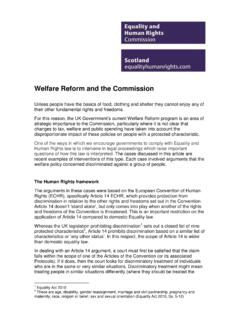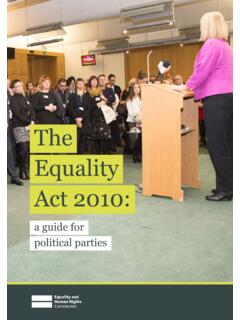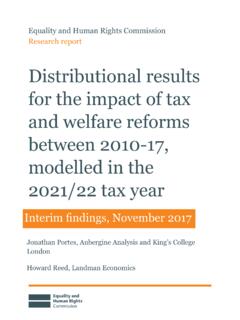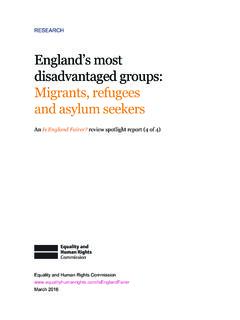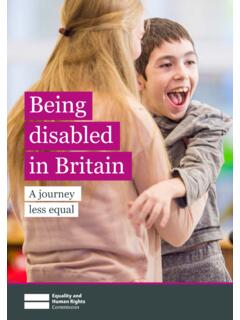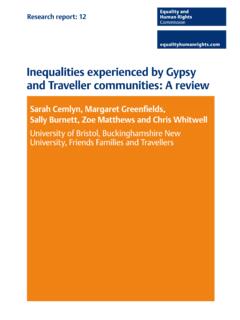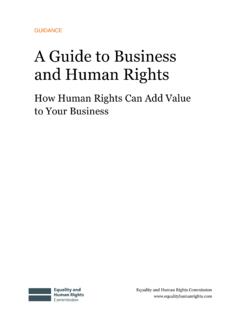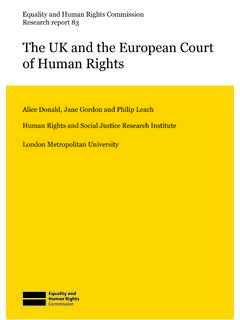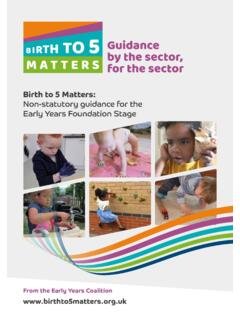Transcription of Your rights to equality at work: working hours, flexible ...
1 GUIDANCE Your rights to equality at Work: working Hours, flexible working and Time Off equality Act 2010 Guidance for Employees Volume 2 of 6 equality and Human rights Commission Your rights to equality at Work: working Hours, flexible working and Time Off Contents Introduction .. 5 Other guides and alternative formats .. 5 The legal status of this 6 What s in this guide? .. 6 What else is in this guide? .. 7 1 | Your rights not to be discriminated against at work: what this means for how your employer must behave towards you .. 8 Are you a worker? .. 8 Protected characteristics .. 8 What is unlawful discrimination ? .. 9 Situations where equality law is different .. 12 Positive action .. 14 Treating disabled workers better than non-disabled workers .. 14 Public sector equality duty and human rights .. 14 What s next in this guide .. 15 Decisions about hours of work and flexible working .. 16 Avoiding direct and indirect discrimination .
2 18 Reasonable adjustments to remove barriers for disabled workers and avoiding discrimination arising from disability .. 21 Requests for changes to hours of work or flexible working on the basis of association with a protected characteristic .. 22 Requests for changes to hours of work or flexible working relating to religion or belief .. 23 Requests for changes to hours of work or flexible working relating to gender 24 A helpful approach for your employer to take .. 25 Decisions relating to time off .. 26 Direct and indirect discrimination .. 27 Reasonable adjustments to remove barriers for disabled workers and avoiding discrimination arising from disability .. 29 Requests for time off relating to religion or belief .. 31 equality and Human rights Commission 2 Updated December 2014 Your rights to equality at Work: working Hours, flexible working and Time Off Requests for time off relating to gender reassignment .. 31 Pregnancy-related absences.
3 32 Maternity, paternity, adoption and parental leave .. 34 Fertility treatment .. 35 2 | When your employer is responsible for what other people do .. 36 When your employer can be held legally responsible for someone else s unlawful discrimination , harassment or victimisation .. 37 How your employer can reduce the risk that they will be held legally responsible .. 38 When your employer s workers or agents may be personally 38 What happens if the discrimination is done by a person who is not your employer s worker or agent .. 39 What happens if a person instructs someone else to do something that is against equality law .. 40 What happens if a person helps someone else to do something that is against equality law .. 40 What happens if an employer tries to stop equality law applying to a 41 3 | The employer s duty to make reasonable adjustments to remove barriers for disabled people .. 42 Which disabled people does the duty apply to?
4 44 How can your employer find out if you are a dis abled person? .. 44 The three requirements of the duty .. 45 Are you at a substantial disadvantage as a disabled person? .. 46 Changes to policies and the way an organisation usually does things .. 47 Dealing with physical barriers .. 47 Providing extra equipment or aids .. 48 Making sure an adjustment is effective .. 49 Who pays for reasonable adjustments? .. 49 What is meant by reasonable .. 50 Reasonable adjustments in practice .. 52 Specific situations .. 58 4 | What to do if you believe you ve been discriminated against .. 60 Your choices .. 61 Was what happened against equality law? .. 62 Ways you can try to get your employer to s ort out the situation equality and Human rights Commission 3 Updated December 2014 Your rights to equality at Work: working Hours, flexible working and Time Off by complaining directly to them .. 63 Monitoring the outcome .. 67 The questions procedure.
5 67 Key points about dis crimination cases in a work situation .. 69 Where claims are brought .. 69 Time limits for bringing a 70 The standard and burden of proof .. 72 What the Employment Tribunal can order the employer to do .. 72 Settling a dispute .. 74 Agreement between you and the employer .. 74 Where to find out more about making a tribunal claim .. 76 5 | Further sources of information and advice .. 77 Glossary .. 86 Contacts .. 104 equality and Human rights Commission 4 Updated December 2014 Your rights to equality at Work: working Hours, flexible working and Time Off Introduction This guide is one of a series written by the equality and Human rights Commission to explain your rights under equality law. These guides support the introduction of the equality Act 2010. This Act brings together lots of different equality laws, many of which we have had for a long time. By doing this, the Act makes equality law simpler and easier to understand.
6 There are six guides giving advice on your rights under equality law when you are at work, whether you are an employee or in another legal relationship to the person or organisation you are working for. The guides look at the following work situations: 1. When you apply for a job 2. working hours and time off 3. Pay and benefits 4. Promotion, transfer, training and development 5. When you are being managed 6. Dismissal, redundancy, retirement and after you ve left Other guides and alternative formats We have also produced: A separate series of guides which explain your rights in relation to people and organisations providing services, carrying out public functions or running an association. Different guides explaining the responsibilities people and organisations have if they are employing people to work for them or if they are providing services, carrying out public functions or running an association. If you require this guide in an alternative format and/or language please contact us to discuss your needs.
7 Contact details are available at the end of the publication. equality and Human rights Commission 5 Updated December 2014 Your rights to equality at Work: working Hours, flexible working and Time Off The legal status of this guidance This guidance applies to England, Scotland and Wales. It has been aligned with the Codes of Practice on Employment and on Equal Pay. Following this guidance should have the same effect as following the Codes and may help employers and others avoid an adverse decision by a court or tribunal in proceedings brought under the equality Act 2010. This guide is based on equality law as it is at 6 April 2014. Any future changes in the law will be reflected in further editions. This guide was last updated in April 2014. You should check with the equality and Human rights Commission if it has been replaced by a more recent version. What s in this guide? If your employer is making decisions about the hours you work, whether you can work flexibly or have time off, equality law applies to what they are doing.
8 equality law applies: whatever the size of the organisation whatever sector you work in whether your employer has one worker or ten or hundreds or thousands whether or not your employer uses any formal processes or forms to help them make decisions. This guide tells you what your employer must do to avoid all the different types of unlawful discrimination . It recognises that smaller and larger employers may operate with different levels of formality, but makes it clear how equality law applies to everyone, and what this means for the way every employer (and anyone who works for them) must do things. It covers the following situations and subjects (we tell you what any unusual words mean as we go along): Decisions about hours of work and flexible working - Avoiding direct and indirect discrimination - Making reasonable adjustments to remove barriers for disabled people and avoiding discrimination arising from disability equality and Human rights Commission 6 Updated December 2014 Your rights to equality at Work.
9 working Hours, flexible working and Time Off - Requests for changes to hours of work or flexible working on the basis of association with a protected characteristic - Requests for changes to hours of work or flexible working relating to a worker s religion or belief - Requests for changes to hours of work or flexible working relating to a worker s gender reassignment Decisions relating to time off - Avoiding direct and indirect discrimination - The specific age exception allowing different levels of annual leave based on length of service of up to five years - Reasonable adjustments to remove barriers for disabled people and avoiding discrimination arising from disability - Requests for time off relating to religion or belief - Requests for time off relating to gender reassignment Pregnancy-related absences - Sickness absence - Ante-natal care Maternity, paternity, adoption and parental leave What else is in this guide?
10 This guide also contains the following sections, which are similar in each guide in the series, and contain information you are likely to need to understand what we tell you about working hours, flexible working and time off: Information about when an employer is responsible for what other people do, such as workers employed by them. Information about reasonable adjustments to remove barriers if you are a disabled person. Advice on what to do if you believe you ve been discriminated against. A Glossary containing a list of words and key ideas you need to understand this guide all words highlighted in bold are in this list. They are highlighted the first time they are used in each section and sometimes on subsequent occasions. These words are explained further in the glossary. Information on where to find more advice and support. equality and Human rights Commission 7 Updated December 2014 Your rights to equality at Work: working Hours, flexible working and Time Off 1 | Your rights not to be discriminated against at work: what this means for how your employer must behave towards you Are you a worker?
